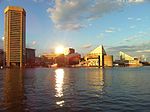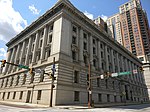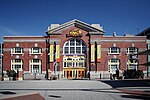Pratt Street Power Plant
1909 establishments in MarylandAdaptive reuse of industrial structures in the United StatesBuildings and structures in BaltimoreEnergy infrastructure completed in 1909Energy infrastructure on the National Register of Historic Places ... and 9 more
ExelonFormer coal-fired power stations in the United StatesFormer power stations in MarylandHistoric American Engineering Record in BaltimoreIndustrial buildings and structures on the National Register of Historic Places in BaltimoreInner Harbor, BaltimorePower stations in MarylandTourist attractions in BaltimoreTowers in Maryland

The Pratt Street Power Plant — also known as the Pier Four Power Plant, The Power Plant, "Pratt Street Toenail", and Pratt Street Station — is a historic former power plant located in downtown Baltimore, Maryland, USA. It has undergone significant repurposing development since retirement and was listed on the National Register of Historic Places in 1987.
Excerpt from the Wikipedia article Pratt Street Power Plant (License: CC BY-SA 3.0, Authors, Images).Pratt Street Power Plant
East Pratt Street, Baltimore
Geographical coordinates (GPS) Address External links Nearby Places Show on map
Geographical coordinates (GPS)
| Latitude | Longitude |
|---|---|
| N 39.286027777778 ° | E -76.607111111111 ° |
Address
The Power Plant
East Pratt Street 601
21202 Baltimore
Maryland, United States
Open on Google Maps









